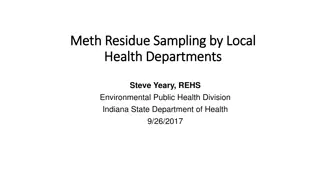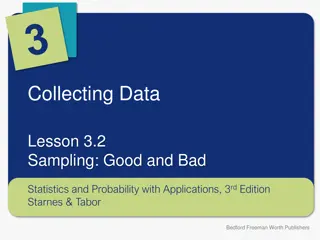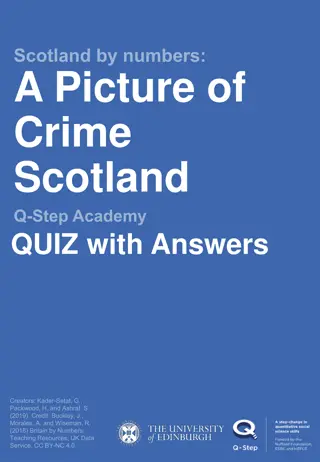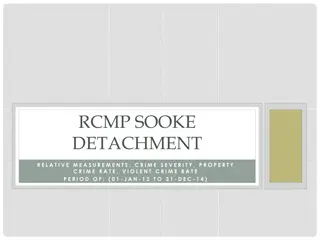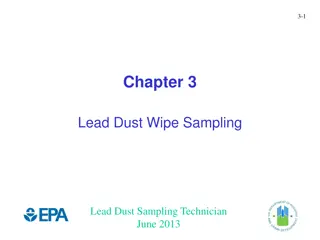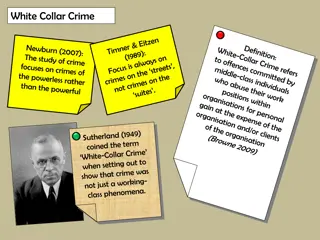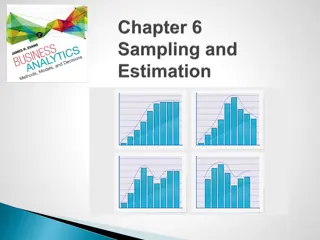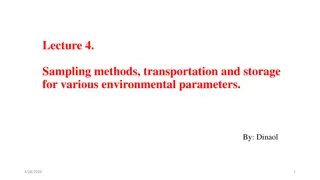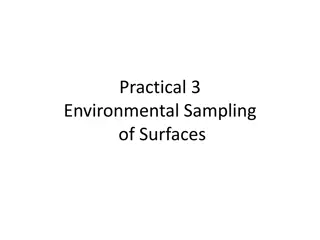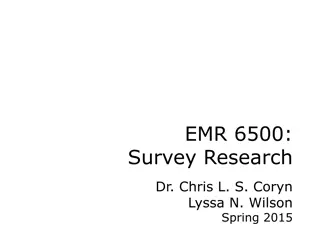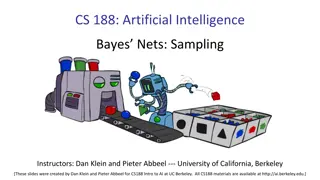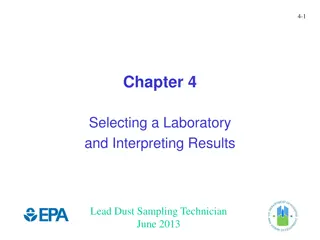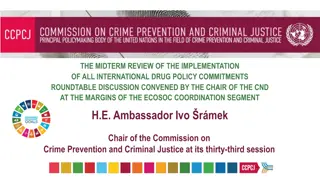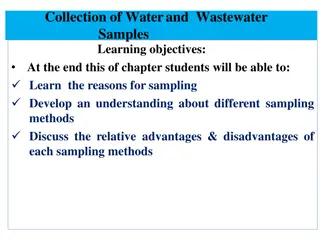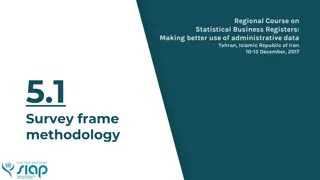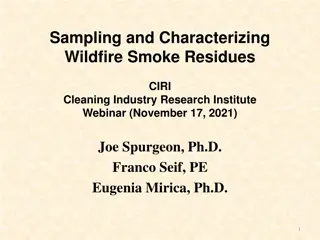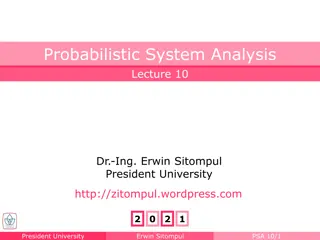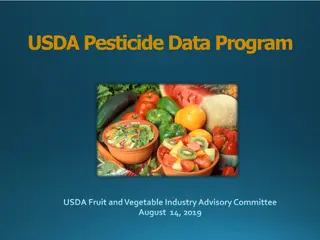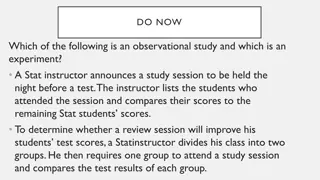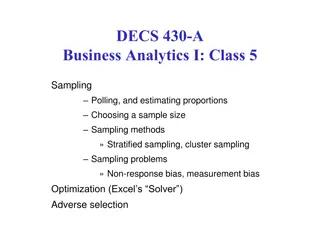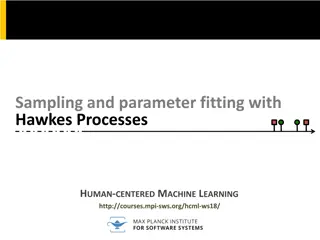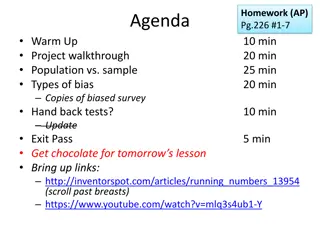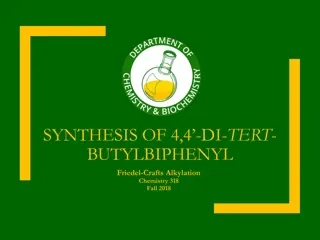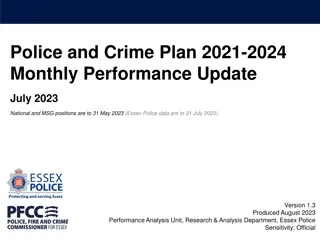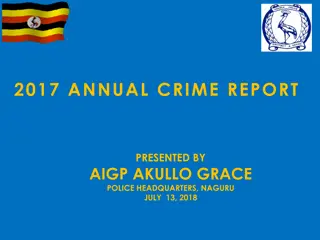State Crime Lab Drug Sampling Protocols
Using the State Crime Lab's drug sampling protocols for defense involves understanding three sampling methods: administrative sample selection, threshold sample selection, and hypergeometric sampling plan. The hypergeometric plan allows experts to make assumptions about the chemical composition of unanalyzed units. If an analyst offers an opinion about unanalyzed materials without using the hypergeometric plan, they must meet certain rules. Pretrial preparation is crucial, including determining the sampling method used, obtaining the testing protocol, and engaging with expert witnesses.
Download Presentation

Please find below an Image/Link to download the presentation.
The content on the website is provided AS IS for your information and personal use only. It may not be sold, licensed, or shared on other websites without obtaining consent from the author. Download presentation by click this link. If you encounter any issues during the download, it is possible that the publisher has removed the file from their server.
E N D
Presentation Transcript
Using the State Crime Labs Drug Sampling Protocols for the Defense By Andrew DeSimone Assistant Appellate Defender
https://encrypted-tbn1.gstatic.com/images?q=tbn:ANd9GcReX97-a5SkXkQuJvmdl1cYinR2HX4fM1CCxyxC3ZiSDjSAf43H4Ahttps://encrypted-tbn1.gstatic.com/images?q=tbn:ANd9GcReX97-a5SkXkQuJvmdl1cYinR2HX4fM1CCxyxC3ZiSDjSAf43H4A
The Current Law When a random sample from a quantity of tablets or capsules appearance is analyzed and is found to contain contraband, the entire quantity may be introduced as the contraband. State v. Myers, 61 N.C. App. 554, 556, 301 S.E.2d 401, 407 (1983) (citation omitted). identical in
Three Sampling Methods 1. Administrative Sample Selection 2. Threshold Sample Selection 3. Hypergeometric Sampling Plan
THE PLAN IS THE ONLY METHOD THAT ALLOWS THE EXPERT TO REPORT ANY ASSUMPTIONS ABOUT THE CHEMICAL COMPOSITION OF THE UNANALYZED UNITS. HYPERGEOMETRIC SAMPLING
If the analyst offers an opinion about the composition of the unanalyzed material (except when using the hypergeometric plan), object under 1. Rule 702 2. Rule 401 3. Rule 602 4. Federal and State Due Process Grounds
Pretrial Preparation 1. Determine what sampling method the analyst used 2. Figure out, and make sure you have, the protocol that was in effect at the time of the testing. 3. Consider meeting with the analyst before trial. 4. Consider talking with your own expert. 5. File a motion in limine or request voir dire of the expert at trial.
Administrative Sample Selection A practice for pharmaceutical preparations and for items when a statutory threshold does not apply. The analyst does a complete chemical analysis of one unit. The analyst can only report the chemical composition of the single analyzed pill. As for the rest, the most the analyst can say is: The physical characteristics, including shape, color and manufacturer s markings of all units were visually examined and found to be consistent with a pharmaceutical preparation containing (insert substance(s) indicated).
Make the Distinction: analyzed and found to contain visually examined and found to be consistent with
Comparing Two Versions of the Administrative Sample Selection Protocol Version 8: Effective August 29, 2014 3.0 Definitions Administrative Sample Selection -A practice for pharmaceutical preparations and for items when a statutory threshold does not apply. No inferences about unanalyzed material are made. Version 10: Effective October 19, 2015 3.0 Definitions Administrative Sample Selection -A practice for pharmaceutical preparations and for items when a statutory threshold does not apply. No inferences about unanalyzed non-pharmaceutical material are made.
If the analyst gives an opinion on the chemical composition of the whole population 1. Raise a discovery violation 2. Object to the opinion under Rules 401, 602, 702, and on federal and state due process grounds 3. Impeach the analyst
N.C. Gen. Stat. 15A-903(a)(2) Upon motion of the defendant, the court must order: The prosecuting attorney to give notice to the defendant of any expert witnesses that the State reasonably expects to call as a witness at trial. Each such witness shall prepare, and the State shall furnish to the defendant, a report of the results of any examinations or tests conducted by the expert. The State shall also furnish to the defendant the expert's curriculum vitae, the expert's opinion, and the underlying basis for that opinion. The State shall give the notice and furnish the materials required by this subsection within a reasonable time prior to trial, as specified by the court....
N.C. Gen. Stat. 15A-910(a) If at any time during the course of the proceedings the court determines that a party has failed to comply with this Article or with an order issued pursuant to this Article, the court in addition to exercising its contempt powers may (1) Order the party to permit the discovery or inspection, or (2) Grant a continuance or recess, or [to consult with/obtain your own expert] (3) Prohibit the party from introducing evidence not disclosed, [preferable] or (3a) Declare a mistrial, or (3b) Dismiss the charge, with or without prejudice, or (4) Enter other appropriate orders
Object under . . . 1. Rule 702 2. Rule 401 3. Rule 602 4. Federal and State Due Process Grounds
State Crime Labs Administrative Procedure for Sampling 5.0 References Guidelines on Representative Drug Sampling. United Nations, New York: United Nations Office on Drugs and Crime, 2009. Frank, Richard S., et. al. "Representative Sampling of Drug Seizures in Multiple Containers." Journal of Forensic Sciences, Volume 36, Issue 2 (March 1991), 350-357. PART III A - Methods of Analysis/Sampling Seized Drugs for Qualitative Analysis. Scientific Working Group for the Analysis of Seized Drugs (SWGDRUG) Recommendations. 5th ed.: January 29, 2010.
SWGDRUG Standards: 2.1.1.2: If an inference about the whole population is to be drawn from a sample, then the plan shall be statistically based and limits of the inference shall be documented. 3.2.2.1: Statistical approaches are applicable when inferences are made about the whole population. 3.2.2.2: Non-statistical approaches are appropriate if no inference is to be made about the whole population. 4: SWGDRUG recommends that each unit comprising the sample shall be analyzed to meet the SWGDRUG minimum recommendations (Part IIIB) for forensic drug identification, if statistical inferences are to be made about the whole population. 5: Inferences drawn from the application of the sampling plan and subsequent analyses shall be documented.
ASTM Standards: 4.2.1.2: If an inference about the whole population is to be drawn from a sample, then the plan should be statistically based and limits of the inference shall be documented. 4.2.2: Statistically selected units shall be analyzed to meet Practice E2329 if statistical inferences are to be made about the whole population. 5.5.1: Statistical approaches are applicable when inferences are made about the whole population. 5.5.2: Non-statistical approaches are appropriate if no inference is to be made about the whole population. 7.1: Inferences based on use of a sampling plan and concomitant analysis shall be documented.
Impeach the analyst Use the protocol, the lab report, and the SWGDRUG and ASTM Standards Elicit Evidence that the analyst did not apply the threshold or hypergeometric sampling plans Elicit evidence that the protocol provides: If additional testing is needed, the prosecuting attorney in the case may contact the Forensic Scientist Manager of the Drug Chemistry Section. Thus, the State had the means to test the material in a manner that might have permitted inferences about the chemical content of whole population, but did not pursue those options
If the analyst conforms his/her testimony to the protocol and only gives an opinion as to the contents of the analyzed portion (which does not satisfy the weight threshold) move to dismiss for insufficient evidence on that particular ground. Request an instruction on a lesser-included offense. Use the analyst s testimony and/or the protocol in closing argument.
Threshold Sample Selection The analyst does a chemical analysis of a sufficient number of units to satisfy the statutory threshold[.]
Hypergeometric Sampling Plan The analyst does a complete chemical analysis of the number of packages in a table provided in the protocol relative to the size of the entire population. The analyst then extrapolates the weight of the entire population. The analyst must report: This material was analyzed with a statistical sampling plan that demonstrates with 95% confidence that at least 90% of the material contains the identified substance(s).
State v. James, 770 S.E.2d 736 (2015) The defendant was convicted of trafficking in 28 grams or more of opium by possession and transportation, and PWISD opium, all for 65 oxycodone pills. The analyst stuck to the Administrative Sample Selection protocol and only gave her opinion that the two pills tested, weighing .99 grams, contained oxycodone. The Court ofAppeals held: Defendant did not cross-examine Agent Matkowsky regarding the sufficiency of the sample size and did not make the sufficiency of the sample size a basis for his motion to dismiss. Therefore, the Court of Appeals dismissed the argument that the State presented insufficient evidence and refused to take judicial notice of the protocol.
Dicta in State v. James Agent Matkowsky testified that she visually inspected the remaining concluded that with regard to color, shape, and imprint, they were consistent with those pills that tested positive for oxycodone. The total weight of the pills was 31.79 grams, exceeding the 28 gram requirement for trafficking. As a result, the State presented sufficient evidence to conclude that defendant possessed and transported 28 grams or more of a Schedule II controlled substance. untested pills and
State v. Lewis, 779 S.E.2d 147 (2015) The defendant was convicted of, inter alia, conspiracy to traffic 14 grams or more but less than 28 grams of opiates for 20 pills The analyst stuck to the Administrative Sample Selection protocol and only gave an opinion that the one pill that was tested tested, weighing .88 grams, contained oxycodone. The Court of Appeals held the trial court did not err by failing to instruct the jury on the requested lesser-included conspiracy to traffic offenses
Get Your Own Expert . . . To testify that there can be no reliable determination of the chemical composition of an entire population of pills based upon a non-statistical approach like administrative sample selection.
State v. Riera, 276 N.C. 361, 172 S.E.2d 535 (1970) The defendant was charged with possession of a barbiturate drug for the purpose of sale, barter, exchange, etc., a felony. The statute at issue provided that possession of one hundred or more tablets, capsules or other dosage forms shall be prima facie evidence of the felony. An expert randomly selected and chemically tested some of the 205 capsules the defendant possessed and found those capsules to contain two distinct barbiturates that were constituent parts of a drug sold under the name Tuinal. The expert also testified the remaining capsules were all identical in coloration, each had an identical code number Lilly F 65 impressed upon it, and the code number indicated that it contained Tuinal. Although the Court rejected the sufficiency argument, the Court granted a new trial because the trial court erred by failing to instruct on the lesser included offense of misdemeanor simple possession of a barbiturate drug, as there was ample evidence to support it.
Other Trial Considerations 1. Request Complete Recordation 2. Make the protocol and the SWGDRUG and ASTM Standards part of the record 3. Continue to object to preserve the issue(s) for appeal constant vigilance 4. Ask for a modification to the pattern instruction on expert testimony. 5. Constitutionalize all objections.
Contact the Office of the Appellate Defender for a Consult Feel free to contact us at any time. always have two lawyers on call to consult with attorneys across the state. We Office of theAppellate Defender 123 W. Main Street, Suite 500 Durham, North Carolina 27701 (919) 354-7210




